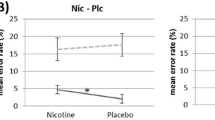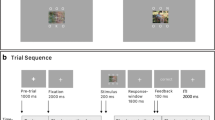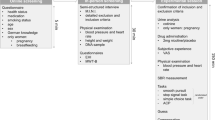Abstract
Rationale and objective
Studies indicate that nicotine enhances some aspects of attention and executive functioning and attenuates the attentional salience of emotionally negative distractors. The purpose of this study was to assess whether nicotine can enhance executive control over prepotent responses in emotional contexts in nonsmokers and whether such enhancement is greater in individuals with low baseline performance (BP).
Methods
The antisaccade task (AST) measures the inhibition of the tendency to glance in the direction of the onset of a visual stimulus and thus is an index of control over prepotent responses. Ten male and 14 female nonsmokers wore nicotine and placebo patches on counterbalanced days that included emotional picture primes and targets.
Results
There were significant beneficial effects of nicotine on antisaccade reaction time (RT). These beneficial effects occurred in individuals with poor and average BP, but not in high baseline performers. In slow baseline RT individuals, nicotine reduced RTs associated with negative targets in the left visual field (VF) and reduced RTs associated with positive and neutral targets in the right VF. In contrast, in the average baseline group, nicotine reduced RTs for positive targets in both VFs and neutral targets in the left VF.
Conclusions
The results suggest that nicotine may produce its effects by enhancing executive functions and that the differential effects as a function of VF, target emotion, and group may also reflect lateralized differences in the effects of nicotine on brain reactivity to emotional stimuli.



Similar content being viewed by others
References
Asgaard GL, Gilbert DG, Malpass D, Sugai C, Dillon A (2010) Nicotine primes attention to competing affective stimuli in the context of salient alternatives. Exp Clin Psychopharmacol 18:51–60. doi:10.1037/a0018516
Carlson JM, Gilbert DG, Riise H, Rabinovich NE, Froeliger B, Sugai C (2009) Serotonin transporter genotype and depressive symptoms moderate effects of nicotine on spatial working memory. Exp Clin Psychopharmacol 17:173–180. doi:10.1037/a0016384
Davidson RJ (1992) Anterior cerebral asymmetry and the nature of emotion. Brain Cogn 20:125–151. doi:10.1016/0278-2626(92)90065-T
Dawkins L, Powell JH, West R, Powell J, Pickering A (2007) A double-blind placebo-controlled experimental study of nicotine: II—effects on response inhibition and executive functioning. Psychopharmacology 190:457–467. doi:10.1007/s00213-006-0634-6
Dolcos F, LaBar KS, Cabeza R (2004) Dissociable effects of arousal and valence on prefrontal activity indexing emotional evaluation and subsequent memory: an event-related fMRI study. Neuroimage 23:64–74. doi:10.1016/j.neuroimage.2004.05.015
Ekman P, Friesen WV (1977) Manual for the facial action coding system. Consulting Psychologists, Palo Alto
Engelmann JM, Gewirtz JC, Cuthbert BN (2011) Emotional reactivity to emotional and smoking cues during smoking abstinence: potentiated startle and P300 suppression. Psychophysiology 48:1656–1668
Eysenck HJ (1973) Personality and the maintenance of the smoking habit. In: Dunn WL (ed) Smoking behavior: motives and incentives. V.H. Winston, Washington, pp 113–146
Eysenck HJ (1997) Addiction, personality and motivation. Human Psychopharmacol 12:S79–S97. doi:10.1002/(SICI)1099-1077(199706)12:2+3.0.CO;2-T
Gainotti G (1972) Emotional behavior and hemispheric side of the lesion. Cortex 8:41–55
Gilbert DG (1995) Smoking: individual differences, psychopathology and emotion. Taylor and Francis, Washington
Gilbert DG (1997) The Situation × Trait Adaptive Response (STAR) model of substance use and craving. Human Psychopharmacol 12:S89–S102. doi:10.1002/(SICI)1099-1077(199706)12:2+3.0.CO;2-P
Gilbert DG, Robinson JH, Chamberlin CL, Spielberger CD (1989) Effects of smoking/nicotine on anxiety, heart rate, and lateralization of EEG during a stressful movie. Psychophysiology 26:311–320. doi:10.1111/j.1469-8986.1989.tb01924.x
Gilbert DG, Sharpe JP, Ramanaiah NV, Detwiler FRJ, Anderson AE (2000) Development of a Situation × Trait Adaptive Response (STAR) model-based smoking motivation questionnaire. Pers Indiv Differ 29:65–84. doi:10.1016/S0191-8869(99)00178-6
Gilbert DG, Rabinovich NE, Rosenberger S (2003) Effects of fast and slow blood-rise nicotine patches on nausea and feeling states in nonsmokers. Poster presented at the Ninth Annual Scientific Sessions of the Society for Research on Nicotine, New Orleans
Gilbert DG, McClernon FJ, Rabinovich NE, Sugai C, Plath LC, Asgaard G, Zuo Y, Huggenvik J, Botros N (2004) Effects of quitting smoking on EEG activation and attention last for more than 31 days and are more severe with stress, dependence, DRD2 A1 allele, and depressive traits. Nicotine Tob Res 6:249–267. doi:10.1080/14622200410001676305
Gilbert DG, Izetelny A, Radtke R, Hammersley J, Rabinovich NE, Jameson TR, Huggenvik JI (2005) Dopamine receptor (DRD2) genotype-dependent effects of nicotine on attention and distraction during rapid visual information processing. Nicotine Tob Res 7:361–379. doi:10.1080/14622200500125245
Gilbert DG, Sugai C, Zuo Y, Rabinovich NE, McClernon FJ, Froeliger B (2007) Brain indices of nicotine’s effects on attentional bias to smoking and emotional pictures and to task-relevant targets. Nicotine Tob Res 9:351–363. doi:10.1080/14622200701188810
Gilbert DG, Carlson JM, Riise H, Rabinovich NE, Sugai C, Froeliger B (2008a) Effects of nicotine and depressive traits on affective priming of lateralized emotional word identification. Exp Clin Psychopharmacol 16:293–300. doi:10.1037/a0012871
Gilbert DG, Rabinovich NE, Malpass D, Mrnak J, Riise H, Adams L, Sugai C, DevlescHoward M (2008b) Effects of nicotine on affect are moderated by stressor proximity and frequency, positive alternatives, and smoker status. Nicotine Tob Res 10:1171–1183. doi:10.1080/14622200802163092
Heishman SJ, Taylor RC, Henningfield JE (1994) Nicotine and smoking: a review of the effects on human performance. Exp Clin Psychopharmacol 2:345–395. doi:10.1037/1064- 1297.2.4.345
Heishman SJ, Kleykamp BA, Singleton EG (2010) Meta-analysis of the acute effects of nicotine and smoking on human performance. Psychopharmacology 210:453–469. doi:10.1007/s00213-010-1848-1
Lang PJ, Bradly MM, Cuthbert BN (1995) International Affective Picture System (IAPS): technical manual and affective ratings. NIMH Center for the Study of Emotion and Attention, Gainesville
Larrison AL, Briand KA, Sereno AB (2004) Nicotine improves antisaccade task performance without affecting prosaccades. Human Psychopharmacol 19:409–419. doi:10.1002/hup. 604
Newhouse PA, Potter A, Singh A (2004) Effects of nicotinic stimulation on cognitive performance. Curr Opin Pharmacol 4:36–46. doi:10.1016/j.physletb.2003.10.071
Perkins KA (1999) Baseline-dependency of nicotine effects: a review. Behav Pharmacol 10:597–615
Perkins KA, Gerlach D, Broge M, Grobe JE, Wilson A (2000) Greater sensitivity to subjective effects of nicotine in nonsmokers high in sensation seeking. Exp Clin Psychopharmacol 8:462–471. doi:10.1037/1064-1297.8.4.462
Petrovsky N, Ettinger U, Quednow BB, Walter H, Schnell K, Kessler H, Mössner R, Maier W, Wagner M (2012) Nicotine differentially modulates antisaccade performance in healthy male non-smoking volunteers stratified for low and high accuracy. Psychopharmacology 221:27–38. doi:10.1007/s00213-011-2540-9
Pettiford J, Kozink RV, Lutz AM, Kollins SH, Rose JE, McClernon FJ (2007) Increases in impulsivity following smoking abstinence are related to baseline nicotine intake and boredom susceptibility. Addict Behav 32:2351–2357. doi:10.1016/j.addbeh.2007.02.004
Pierrot-Deseilligny C, Müri RM, Ploner CJ, Gaymard B, Demeret S, Rivaud-Pechoux S (2003) Decisional role of the dorsolateral prefrontal cortex in ocular motor behaviour. Brain 126:1460–1473. doi:10.1093/brain/awg148
Pizzagalli D, Shackman AJ, Davidson RJ (2003) The functional neuroimaging of human emotion: asymmetric contributions of cortical and subcortical circuitry. In: Hugdahl K, Davidson RJ (eds) The asymmetrical brain. MIT, Cambridge, pp 511–532
Powell JH, Pickering AD, Dawkins L, West R, Powell JF (2004) Cognitive and psychological correlates of smoking abstinence, and predictors of successful cessation. Addict Behav 29:1407–1426
Rose JE, Behm FM, Westman EC, Mathew RJ, London ED, Hawk TC, Turkington TG, Coleman RE (2003) PET studies of the influences of nicotine on neural systems in cigarette smokers. Am J Psychiatry 160:323–333
Rycroft N, Hutton SB, Clowry O, Groomsbridge C, Sierakowski A, Rusted JM (2007) Non-cholinergic modulation of antisaccade performance: a modafinil-nicotine comparison. Psychopharmacology 195:245–253. doi:10.1007/s00213-007-0885-x
Smith SD, Bulman-Fleming MB (2005) An examination of the right-hemisphere hypothesis of the lateralization of emotion. Brain Cognit 57:210–213. doi:10.1016/j.bandc.2004.08.046
Spielberger CD (1986) Psychological determinants of smoking behavior. In: Tollison RD (ed) Smoking and society: toward a more balanced assessment. DC Heath, Lexington, pp 89–134
Tabibnia G, Monterosso JR, Baicy K, Aron AR, Poldrack RA, Chakrapani S, Lee B, London ED (2011) Different forms of self-control share a neurocognitive substrate. J Neurosci 31:4805–4810. doi:10.1523/JNEUROSCI.2859-10.201
Thiel CM, Fink GR (2008) Effects of the cholinergic agonist nicotine on reorienting of visual spatial attention and top-down attentional control. Cognit Neurosci 152:381–390. doi:10.1016/j.neuroscience.2007.10.061
Acknowledgments
The authors thank Norka Rabinovich, Raghuveer Kanneganti, Hannah Sturm, Jason Holdener, and Kevin Russell for their help in conducting this study. This research was funded by a Research-Enriched Academic Challenge awarded to the first author by the Southern Illinois University Carbondale Office of Sponsored Projects Administration.
Conflict of interest
The authors have no competing interests.
Author information
Authors and Affiliations
Corresponding author
Rights and permissions
About this article
Cite this article
Wachter, N.J., Gilbert, D.G. Nicotine differentially modulates antisaccade eye-gaze away from emotional stimuli in nonsmokers stratified by pre-task baseline performance. Psychopharmacology 225, 561–568 (2013). https://doi.org/10.1007/s00213-012-2842-6
Received:
Accepted:
Published:
Issue Date:
DOI: https://doi.org/10.1007/s00213-012-2842-6




